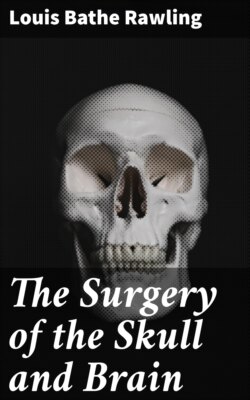Читать книгу The Surgery of the Skull and Brain - Louis Bathe Rawling - Страница 71
На сайте Литреса книга снята с продажи.
Symptoms.
ОглавлениеBesides the history of protracted labour and the ‘blue’ asphyxiated appearance of the baby, other evidence is to hand with respect to both general and local increase of brain-pressure.
The general increase is evidenced first and foremost by the bulging and non-pulsatile anterior fontanelle. The fontanelle may be regarded as an index of intracranial pressure. The margins of the fontanelle are outlined with some difficulty, and, owing to the free communication between the intra- and extra-cranial venous systems, the scalp-veins are unduly prominent. The general condition of the child varies according to rise of intracranial pressure. In the more serious cases it may be impossible to arouse the patient: in the slighter hæmorrhages the child may appear but little the worse, with the exception, perhaps, of being rather more irritable than usual.
The effect of the pressure on the medullary centres is shown by respiratory difficulties—irregularities of rhythm, &c.—some retardation in pulse-rate, and increase in blood-pressure. The reflexes are increased and the child is readily thrown into general convulsions.
The effect of the localized pressure on the upper Rolandic centres seldom becomes evident till after the lapse of a few days—and often after a longer period—when muscular weakness, twitchings, rigidity, or paralysis—more especially of the contralateral lower extremity—becomes apparent. The mother often draws attention to the fact that the child does not move one of its legs properly.
When the extravasation is extensive, spreading downwards over other motor areas, the upper extremities and even the face may be involved.
When a small hæmorrhage is present, situated on either side of the falx cerebri, both lower extremities suffer and diplegia results.
In some cases, chemosis of the conjunction, œdema of the lids, and proptosis have been observed. In any case an ophthalmoscopic examination should be carried out. Frequently some fullness of the retinal veins and diminution in the calibre of the arteries supply confirmatory evidence.
In the event of doubt in diagnosis, lumbar puncture should be carried out. It should be noted, however, that although the positive evidence of free blood corpuscles points to subdural hæmorrhage, yet that absence of blood in the fluid withdrawn does not exclude the possibility of a localized and more or less encapsulated hæmorrhage. In the event of failure at recognition of the serious lesion present, disastrous results will ensue—monoplegia, diplegia, hemiplegia, epilepsy, and idiocy.
